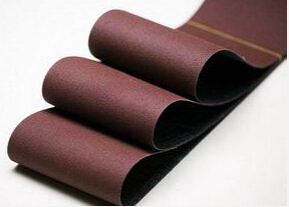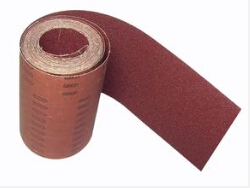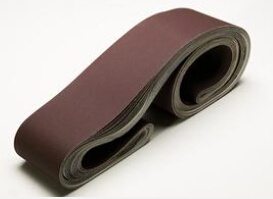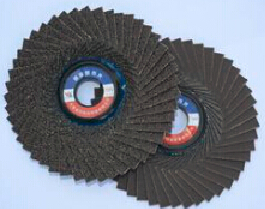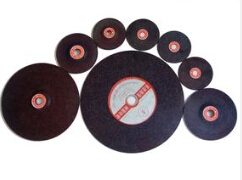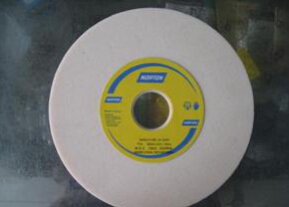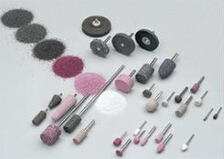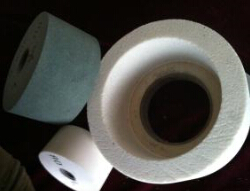Grinding Wheel Introduction
Zhongsen Editor 2016-09-30Grinding wheel is one of the major type of abrasive tools in the process of grinding.The grinding wheel is a porous material which is formed by the pressing of the blank, the drying and the roasting. Due to different abrasive, bonding agent and manufacturing process, the characteristics of grinding wheel is very different. So it has an important influence on the quality, productivity and economy of the grinding process. The characteristics of the grinding wheel are mainly determined by the factors such as abrasive, grain size, bond, hardness, structure, shape, size and so on. At the same time, the grinding wheel is widely used in the abrasive tools. It can make rough grinding, semi fine grinding, fine grinding notching and cutting for metal or nonmetal workpiece cylindrical, inner circle, plane and various surface when using with high-speed rotation.
Classification:
There are many different kinds of grinding wheel with all sorts of shapes and sizes. Due to the grinding wheel abrasive, binder materials and grinding wheel manufacturing process is different, all kinds of grinding wheel has different performance.Each kind of grinding wheel has a certain scope of application according to its own characteristics. By the use of abrasive can be divided into ordinary abrasive (corundum and silicon carbide ) grinding wheel and natural super hard abrasive (diamond and CBN grinding wheel etc.). According to the shape can be divided into flat wheel, bevel wheel, cylinder wheel and cup wheel, disc wheel. According to the binder can be divided into ceramic grinding wheel, resin wheel, rubber wheel, the metal grinding wheel, etc.The characteristic parameters of the grinding wheel mainly include abrasive, grain size, hardness, bond, shape, size and so on.
Production Process:
Ordinary grinding wheel process has the following 8 steps: 1. Ingredients: according to the formula required to weigh a variety of required raw materials. 2. Mix material: according to the process requirements of the abrasive material and other kinds of materials to mixed for the molding process according to the order and the time required. 3. Molding: the process of using of the press and the mold will be pressed into the required shape of the grinding wheel blank. 4, Drying: divided into the natural drying and artificial drying. 5, Sintering: during this process, the ceramic grinding wheel is called sintering; resin grinding wheel is called hardening; rubber wheel is called curing. The whole process is completed by the change of the temperature. 6. Processing: the outer circle, the plane and the hole diameter of the burned - out body are processed by a lathe or grinder. Some are also need to fill holes and sulfur, invasion of wax, etc.. 7, Inspection and seal: it should take a strict inspection on the product appearance, size, hardness, balance, strength and so on to make it meet the requirements of the standard of qualified products. The seal of the standard requirements should according to the batch print product certificate. 8, Storage packaging: packaging should in accordance with requirements of qualified products and then put in storage.
I. Normal Grinding wheel
Grinding wheel is a circular bonded abrasive tools, which is made of abrasive and binder.
The characteristic of the grinding wheel is determined by these factors such as abrasive, grain size, hardness, bond, shape and size.
1.The selection of abrasive grain
The abrasive is the main raw material for making the grinding wheel. It is responsible for the cutting work. Therefore, the abrasive must be sharp and have a high hardness, good heat resistance and a certain degree of toughness.
The most commonly used abrasive is Brown fused alumina (A) and white fused alumina(WA), followed by black silicon carbide (C) and green silicon carbide (GC), and other commonly used pink fused alumina (PA), single crystal corundum (SA), microlite corundum(MA), zirconia alumiona (ZA).
Brown corundum grinding wheel: brown fused alumina has high hardness and toughness, suitable for grinding high tensile strength metal, such as carbon steel, alloy steel, malleable cast iron, hard bronze, etc. This kind of abrasive grinding performance is good and wide adaptability. It often used for removal of larger allowance for coarse grinding and price is cheap, can be widely used.
White corundum grinding wheel: the white corundum hardness is slightly higher than that of brown fused alumina, toughness is lower than brown fused alumina. Grain is broken easily when grinding. So, the grinding heat is small, suitable for manufacturing fine grinding hardened steel, high carbon steel, high speed steel and the grinding wheel which are used for grinding thin-walled parts. The cost is higher than brown fused alumina.
Black silicon carbide grinding wheel: black silicon carbide are sharp and crisp, hardness higher than white corundum. It’s suitable for grinding the lower mechanical strength of materials, such as cast iron, brass, aluminum and refractory, etc.
Green silicon carbide grinding wheel: harder and more brittle than black silicon carbide, very sharp for grinding and of good heat conductivity. It’s suitable for grinding hard alloy, optical glass, ceramics and other hard brittle materials.
Pink fused alumina grinding wheel: suitable for grinding tools, measuring tools, instruments, thread and other surface processing high quality requirements artifacts.
Single-crystal corundum grinding wheel: suitable for grinding stainless steel, high vanadium high speed steel, such as toughness, high hardness materials and the workpiece which is easy to burn and deformed.
Microlite corundum grinding wheel: suitable for grinding stainless steel, bearing steel and special nodular cast iron, etc. It’s used for forming grinding, grinding, mirror grinding.
Zirconium corundum grinding wheel: suitable for grinding the stainless steel, titanium alloy, heat-resistant alloy, especially suitable for heavy-load grinding.
2.The selection of particle size
Grain is referred to as the abrasive particle size and is expressed in grain sizes. When grinding with a coarse-grained grinding wheel, the production efficiency is high but the grinded surface of workpiece is relatively coarse;When grinding with fine-grained grinding wheel, the grinded workpiece has good surface roughness but the productivity is low.Under the premise of meeting the roughness requirement should choose coarse-grained grinding wheel to ensure that higher grinding efficiency.Generally choosing coarse-grained grinding wheel when coarse grinding, fine grinding when choose fine-grained grinding wheel.
When the grinding wheel and workpiece contact area is larger, should choose some coarse-grained grinding wheel. For example, take the same grinding plane, grinding with face thicker than the periphery of the grinding when choosing particle size.
3.The selection of hardness
Depends mainly on the choice of grinding workpiece materials, grinding efficiency and machining surface quality.
The hardness refers to how difficult of grinding grain fall off when grinding wheel under the action of external force. In order to meet the requirements of different workpiece materials, divided into different hardness level when manufacturing grinding wheel.
The application scope of different hardness grinding wheel When choose a grinding wheel which was more hard, the grinding grain is not easy to fall off. It’s easy to jam and increase the grinding heat, the workpiece gets burn easily and low efficiency. It will influence workpiece surface quality;When choose too soft grinding wheel, it will fall off when the grain was sharp and increased the grinding wheel wear, easy to lose the correct geometry and affect the precision of workpiece.Therefore, the choice of grinding wheel hardness should be appropriate, but also according to the grinding wheel and the workpiece contact area size, the shape of the workpiece, the way of grinding, cooling, grinding wheel type and other factors to consider.
4.The selection of binding agent
Should be based on the grinding method, the use of speed and surface processing requirements and other conditions to be considered.
The most commonly used grinding wheel bond is ceramic binder (V) and resin binder (B).
Ceramic bond is a kind of inorganic binder with stable chemical performance, heat resistance, good corrosion resistance, large porosity. Manufactured grinding wheel with this bond will be high efficiency, small abrasion, can keep the wheel geometry, and can be used widely.It’s suitable for grinding the ordinary carbon steel, alloy steel, stainless steel, cast iron, hard alloy and non-ferrous metals, etc.However, ceramic bond wheel brittleness is bigger that can’t stand severe vibration. Normally only used within 35 m/s speed.
The resin bond is an organic bond, which has high strength, elasticity, low heat resistance, good self sharpening property, simple manufacture and short process cycle. It can be made faster than 50 m / s of the grinding wheel and very thin grinding wheel. The scope of its application second only to ceramic binder, widely used for coarse grinding, grinding, cutting and grinding waste free, such as grinding burr of casting ingot and so on. It can be make high-speed, high finish grinding wheel and heavy load, cut off and a variety of special requirements of the grinding wheel.
5.The selection of structure
Mainly consider the workpiece by pressure, grinding method, workpiece material etc..
The structure of the grinding wheel refers to the volume proportion relationship between the abrasive, the bond and the void of the grinding wheel. The grinding wheel is usually classified as a percentage of the grinding wheel. There are three kinds of organization(close, medium, loose) a total of 15 # (0 ~ 14), the organization is smaller, the greater the proportion of abrasive, the more dense of the grinding wheel. The grinding wheel is not easy to be blocked, and the cutting fluid or air can be brought into the cutting area, the grinding temperature is reduced. But the grinding grain content is small will be easy to wear and lose the correct shape. So the loose wheel should be adopted when coarse grinding, fine grinding wheel should adopt more close organization.
5.The selection of shape and size According to the need of the machine tool structure and grinding process, the grinding wheel is made into various shapes and sizes.Table 3 is the commonly used several kinds of grinding wheel shape, size, code and purpose.
Grinding wheel diameter should be selected as big as possible in order to improve the grinding wheel peripheral speed so that improve the productivity and the surface roughness of grinding.In addition, under the condition of the machine tool stiffness and power license, will increase productivity and reduce the effect of the roughness if choose the width of the grinding wheel. But to avoid burns and cracks on the surface of the workpiece when grinding the high heat-sensitive material, the grinding wheel width should be reduced.
The characteristics of grinding wheel are marked on the side of the grinding wheel, the order is: code number, size, abrasive, grain size, shape, hardness, structure number, binder and the highest speed.Such as: grinding wheel 1-300 * 75 - A60S6V 30-35 m/s, express that the flat wheel diameter is 300 mm, thickness of 30 mm, inner diameter 75 mm. Brown corundum abrasives, 60 # particle size, the hardness is 1 level, No 6 structure ceramic bond, the highest speed is 35 m/s.
II. Diamond Grinding Wheel
Diamond grinding wheel is sharper than the grinding wheel which is made of general abrasives such as boron carbide, silicon carbide, corundum, etc. It’s less abrasion with high productivity, long service life and good quality but the price is expensive. Therefore it is suitable for the grinding of hard alloy, ceramic, semiconductor and other high hardness brittle hard material.
The characteristics of the diamond grinding wheel includes abrasive type, particle size, hardness, concentration, binder, grinding wheel shape and size.
Abrasive: widely used artificial diamond (JR), it’s divided into various models according to its crystal shape and particle strength. According to their specific purposes to select models
Granularity: taking three aspects of workpiece roughness, diamond grinding productivity and consumption into account.
Hardness: only the resin bond diamond grinding wheel has the characteristic of "hardness". Generally use S (Y1) or higher.
Binder: there are four kinds of commonly used binders, the binding capacity and wear resistance is in the order of resin, bronze, ceramics and metal plating. The resin bond diamond grinding wheel has high grinding efficiency, good roughness of the processed workpiece and wide application range. It has good self sharpening and not easy jam, small heat and easy dressing and is mainly used for the fine grinding process. The ceramic bond diamond grinding wheel is mainly used in the grinding of various kinds of non-metal hard and brittle materials, hard alloy, super hard material and so on.
Concentration: the choice of concentration is decided by the size of the grinding wheel, bond, shape, processing methods, production efficiency and the requirements of grinding wheel life. High concentration of diamond grinding wheel aims to maintain the shape of the grinding wheel. When grinding with low concentration of grinding wheel, diamond consumption is often lower, should be based on the need to select appropriately.
The shape and size: selected according to the shape and size of the workpiece and the condition of machine tool.
III. CBN Grinding Wheel
The cubic boron nitride particle of cubic boron nitride (CBN) grinding wheel sticks in ordinary grinding wheel surface is only a very thin layer. The abrasive particle toughness, hardness and durability is more 100 tines than corundum grinding wheel. It’s most suitable for the processing and high hardness,big viscosity, high temperature and high strength, low thermal conductivity hard grinding of steel and high speed and ultra-high speed grinding.Its application scope plays complementary role with the synthetic diamond. The diamond grinding wheel has a unique effect when grinding hard alloy and non-metallic materials. But when grinding steel material, especially when grinding, special steel, the effect is not significant. The grinding efficiency of Cubic nitride grinding wheel is nearly one hundred times higher than the type of corundum grinding wheel, five times higher than the diamond wheel but less than the diamond grinding of brittle materials.
The choice of cubic boron nitride grinding wheel is similar to the choice of diamond grinding wheel. But in the selection of binder, most of the resin bond, the second is electroplating, metal bond. Vitrified CBN grinding wheel mainly used for grinding of titanium alloy, high speed steel, malleable iron and hard processing of ferrous metal. Resin bonded CBN wheel is suitable for the grinding of ferromagnetic materials, is the ideal choice of steel processing. CBN grinding wheel concentration is generally used between the 100%~150% more economical and reasonable, it can not be used with ordinary cutting fluid but special cutting fluid.
IV. Developing Trend
Grinding is a processing cutting with uncertain edges, the grinding technology at present, not only puts forward new requirements for grinding machine equipment, but also higher requirements for grinding tools. All abrasive mold manufacturers make efforts in various aspects in order to improve the accuracy and efficiency, reduce cost to adapt and develop new products to improve their competitive ability. Abrasives should make efforts in the shape of particles and cleanliness.In addition, the backlog of fine powder and dusting powder is serious. We should also solve and strengthen these problems that how to make these products and by-products used fully.In addition to grinding, the abrasive should be studied and developed to the field of non grinding. Resin abrasive tools should be improved in the cutting force and resolve the ability of anti-decay of abrasive tools. Especially for heavy-duty wheel, there is a big quality difference in steel mills and rail wheel. High-grade ceramic abrasive tools especially with CNC machine tools should pay more attention to research and development as high speed and high efficient grinding tools are relatively small.
In recent years, with the further research of the high-end technical personnel, as well as the application of new materials, the quality of domestic grinding wheel generally have been improved, grinding wheel become more sharp and durable. The market began to show oversupply situation, so the price competition has become increasingly fierce, prices and profit margins have declined, but the quality requirements for the market has never been reduced. A lot of grinding wheel manufacturers have also introduced a variety of promotional plan to stabilize customers or win more market. As the saying goes that he who does not advance loses ground. For foreign buyers, in the premise of ensuring the quality, most buyers will choose the supplier whose price is more competitive especially OEM customers.

